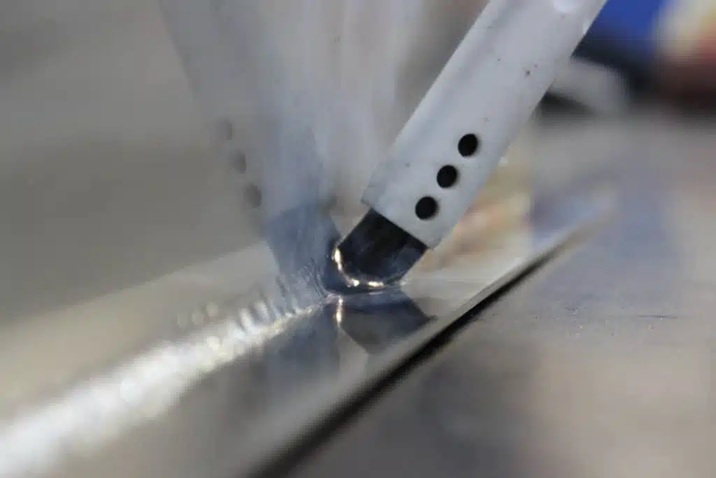Electropolishing is a metal finishing process that improves both the appearance and functionality of metal products. Popular in industries like medical technology, food processing, and aerospace, it stands out for its ability to refine metal surfaces effectively. This blog explains how electropolishing works and why it’s a top choice for enhancing metal products.
What is Electropolishing?
Electropolishing is a specialized electrochemical process used to polish, passivated, and deburr metal surfaces. Unlike mechanical polishing methods that remove surface material through abrasion, electropolishing dissolves microscopic layers of metal ions using an electrochemical solution.
The result? A smooth, mirror-like finish that not only looks stunning but also improves the metal’s performance by reducing surface roughness, increasing corrosion resistance, and removing imperfections like burrs and weld marks. Electropolishing works on a variety of metals, including stainless steel, aluminum, brass, and titanium, making it a versatile choice for countless applications.
What Are the Core Benefits?
- Aesthetic appeal: Achieves a high-gloss, reflective surface free from scratches and blemishes.
- Improved functionality: Enhances corrosion resistance, reduces friction, and simplifies sterilization processes.
- Precision processing: Targets even the smallest crevices and complex designs for consistent results.
The Science Behind Electropolishing
At its core, electropolishing is an electrochemical process. It involves submerging a metal object in an electrolytic bath—a solution often composed of acids designed to chemically react with the metal surface. An electric current is then applied to the object (acting as the anode), causing metal ions to dissolve from high points on the surface, effectively ‘leveling out’ irregularities.
Here’s how the process works step-by-step:
- Preparation: The metal is thoroughly cleaned to remove dirt, grease, or contaminants that could interfere with the electrochemical reaction.
- Electrolytic bath: The object is immersed in the bath, and an electrical current is applied.
- Polishing reaction: Metal ions selectively dissolve from the surface’s high points, creating a smoother and more uniform appearance.
- Final rinse: The piece is rinsed to remove residual acid and dried for inspection.
By reducing surface roughness at a microscopic level, electropolishing creates not only a visually flawless appearance but also a chemically stable surface that resists corrosion, promotes longevity, and meets regulatory cleanliness standards required by industries like medical and food manufacturing.
Applications of Electropolishing
Electropolishing isn’t just about shiny surfaces (although the results can be jaw-dropping). Its functional benefits make it indispensable in industries where performance and precision are critical. Below are some key fields where electropolishing plays a vital role:
Medical Devices
From surgical instruments to implants, electropolishing is essential for creating a smooth surface that minimizes bacterial growth and allows for easy sterilization. Its precise finish also reduces friction, making devices more reliable and comfortable for patients.
Pharmaceutical and Food Processing Equipment
Electropolished stainless steel tanks and piping are frequently used in food and drug manufacturing facilities. The smooth, non-porous finish prevents contaminants from building up and ensures compliance with hygiene regulations.
Aerospace and Automotive
Precision parts, like turbine blades or fuel system components, benefit from the improved corrosion resistance and aerodynamic smoothness achieved through electropolishing. The process also removes potential stress points caused by surface imperfections, increasing durability under high-pressure conditions. To complement processes like electropolishing, selecting reliable Car Shipping Companies New York ensures that high-quality components or finished products are transported securely to their destination.
Consumer Products
Think of the shiny finish on your kitchen appliances or jewelry. Electropolishing enhances the visual appeal of everyday items while also improving their resistance to wear and corrosion.
Electropolishing vs. Other Finishing Methods
So, what sets electropolishing apart from other finishing techniques like mechanical polishing, passivation, and anodizing?
- Mechanical Polishing: While both methods can achieve a smooth surface, mechanical polishing also removes metal material in the process. This can cause microscopic grooves that trap bacteria and weaken the metal’s structure.
- Passivation: This method uses acids to remove free iron particles on the surface of stainless steel. However, it does not enhance surface roughness or eliminate burrs and imperfections. It is often used in combination with electropolishing for optimal results.
- Anodizing: Anodizing is primarily used to add a protective layer on the surface of aluminum, making it more resistant to corrosion. It does not remove surface imperfections or enhance aesthetics.
Environmental and Economic Benefits of Electropolishing
While the focus often falls on aesthetics and performance, electropolishing offers significant environmental and economic benefits as well:
- Reduced material waste: The electrochemical process removes only microscopic layers of metal, resulting in less waste compared to mechanical grinding or machining.
- Energy efficiency: Once set up, the process requires less energy than other polishing methods.
- Eco-friendly options: Many electropolishing services use cleaner, greener electrolytic solutions to minimize the ecological footprint.
Cost-wise, electropolishing can deliver savings by extending the lifespan of components, reducing maintenance, and improving energy efficiency over the long term.
How to Choose the Right Electropolishing Service
Not all electropolishing services are created equal. Here are a few factors to consider when selecting a provider:
- Experience and expertise: Look for companies with a solid track record and experience working within your specific industry, such as Zinc Plating Specialists.
- Certifications: Ensure the provider meets relevant industry standards, such as ISO 9001 or FDA compliance for medical device manufacturers.
- Custom solutions: Choose a service that customizes its approach to your needs, whether for small, intricate parts or large industrial components.
- Customer reviews: Don’t underestimate the power of client testimonials when evaluating reliability and quality.
Compare providers by requesting samples or case studies to see the quality of their work before committing.
Unlock the Power of Electropolishing for Your Business
Electropolishing is more than just a metal finishing process—it’s a tool for transformation. From medical instruments to aerospace components, it delivers unparalleled advantages in aesthetics, functionality, and sustainability.
Is it time to elevate the quality of your metal products? Whether you’re designing high-performance parts or striving for a flawless finish, electropolishing could be the answer. Start exploring its benefits and find the right service provider today to transform your vision into reality.
Conclusion
Now that you have a solid understanding of what electropolishing is and its many benefits, it’s time to take action. Whether you’re already using this process in your production or are considering implementing it, make sure to partner with an experienced and reputable service provider for the best results.










